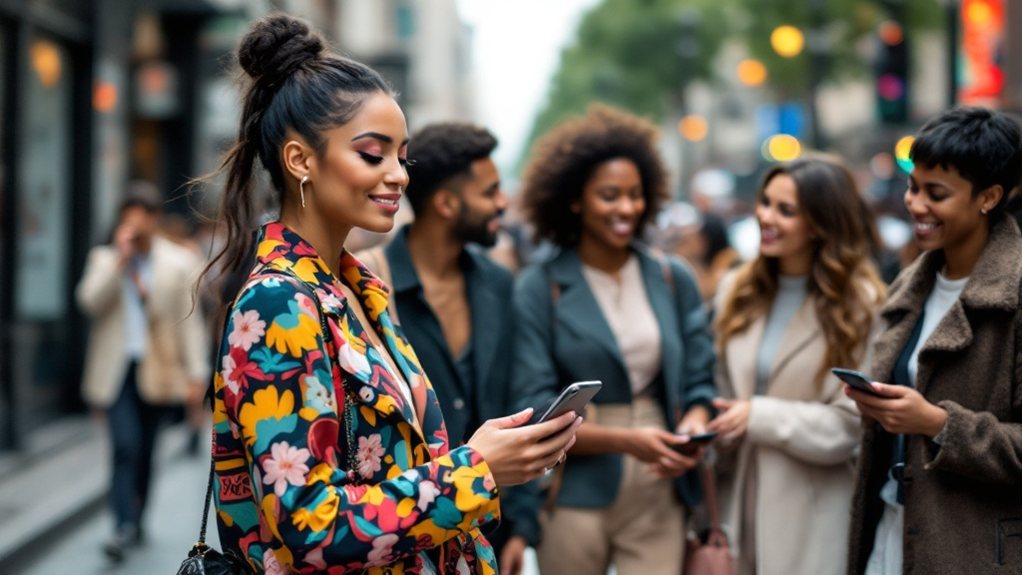Boost your blog's local visibility by partnering with influential community members. Define your goals, identify the right target audience, and select the most relevant social platforms. Allocate a strategic influencer marketing budget, tracking engagement and impact. Leverage social listening and hashtag research to find the perfect collaborators, then work together on authentic, engaging content. By optimizing your influencer strategy, you'll drive measurable results for your blog. Want to learn more?
Defining Goals for Leveraging Local Influencers

When leveraging local influencers, you'll want to clearly define your goals from the outset. This could include increasing brand visibility and awareness, reaching a local audience, enhancing credibility through authentic endorsements, and fostering engagement with genuine content. Align influencer messaging with your business values and drive conversions through personalized marketing. Additionally, you may aim to generate leads and sales by creating valuable content that resonates with the local community. Utilize influencer networks for product promotion and develop strategic partnerships for mutual benefit. Measure the effectiveness of your campaigns by tracking engagement rates, conversion numbers, brand mentions, and local awareness.
Identifying the Target Audience

To effectively leverage local influencers, you'll first need to identify your target audience. Understand their age, location, and gender, as these factors will guide your influencer selection. Analyze their behavioral attributes, such as spending habits and interests, as well as their income level. This information will help you find influencers whose content resonates with your audience.
Consider their psychographic profile, including personality traits, values, and lifestyle choices. Examine their attitudes towards brands and their affinity for certain activities. Understanding your audience's interests and hobbies, as well as their content engagement, will further refine your influencer strategy. Local influencers can help you reach a specific geographical area within your target market.
- General interests (e.g., fashion, food, technology)
- Specific hobbies (e.g., gardening, music, photography)
- Information sources (e.g., blogs, podcasts, social media)
Selecting Relevant Social Media Platforms

To maximize your blog's visibility, you'll need to identify the social media platforms that align best with your target audience. Consider factors like content style preferences, audience demographics, and the ability to leverage location-based targeting to connect with local influencers. Leveraging the right platforms can significantly enhance your influencer marketing efforts and drive targeted traffic to your blog.
Optimal Platform Identification
Selecting the optimal social media platforms for your blog visibility requires a nuanced approach. Consider your target audience, content type, and engagement metrics to identify the most effective channels.
- Instagram's visual focus makes it ideal for showcasing your blog's aesthetics and collaborating with local influencers. Local influencers can perform well on certain platforms in some countries but not others.
- Leverage TikTok's short-form video format to create engaging, trend-driven content that resonates with younger audiences.
- Utilize YouTube's long-form capabilities to provide in-depth product reviews, tutorials, and storytelling that solidifies your authority.
Audience Engagement Alignment
Effective audience engagement begins with aligning your social media platform selection to your target demographics. Understand which platforms your audience frequents – this is crucial for identifying relevant local influencers. Different platforms favor distinct content formats, so tailor your approach accordingly. For instance, TikTok thrives on short-form videos, while Instagram lends itself to visual storytelling. Leverage interactive content like polls and challenges to boost engagement on specific platforms. Additionally, localizing your content to reflect regional interests can significantly increase audience participation. Utilize influencer marketing tools to streamline the process of finding local voices that resonate with your target community.
Budgeting for Influencer Partnerships
When working with local influencers, you'll need to consider various cost factors. Identifying the right influencers in the niche is crucial as their audience and values must align with the target demographic. Determine the right compensation model, whether it's product gifting, modest fees, or comprehensive financial arrangements. Additionally, budget for content creation, event participation, and any hidden costs like agency fees or travel expenses.
Determining Influencer Compensation
Determining the appropriate compensation for local influencers is a crucial step in building successful partnerships. When negotiating compensation, consider these key factors:
- Influencer's Reach and Engagement: Evaluate their audience size, demographics, and average engagement rates to gauge their value.
- Collaboration Scope: Assess whether you're seeking sponsored posts, events, or co-branded content, as this impacts the compensation model.
- Performance Tracking: Implement tools to monitor the influencer's impact on your desired metrics, such as website traffic or sales. Geographical market appeal is an important consideration when determining appropriate pricing.
Budgeting for Content Creation
Budgeting for influencer partnerships requires careful consideration of various factors. From influencer types and their corresponding costs to the different content formats and platforms, each element impacts your overall budget. Evaluate nano-influencers for cost-effective collaborations, while macro- and mega-influencers command higher fees due to their extensive reach. Similarly, complex video content creation incurs greater expenses than simpler social media posts. Additionally, consider local versus global influencers, tailoring your approach to your campaign goals. Maintaining positive relationships and clear communication with influencers can lead to longer-term partnerships or frequent, short-term collaborations. Ultimately, track key metrics to measure the return on your investment and guide future budget allocations.
| Influencer Type | Typical Follower Count | Cost Range |
|---|---|---|
| Nano-influencer | 1,000 – 10,000 | Low |
| Macro-influencer | 100,000+ | High |
| Mega-influencer | 1 million+ | Highest |
Allocating Promotional Spend
How should you allocate your promotional spend when budgeting for influencer partnerships? Start by aligning your budget with specific campaign goals, whether that's brand awareness, conversions, or engagement. Then, consider allocating funds based on influencer tiers:
- Macro-influencers with large followings
- Mid-tier influencers with engaged audiences
- Micro-influencers with hyper-targeted reach
Additionally, don't forget to factor in performance-based incentives and the duration of partnerships. The importance of planning the influencer marketing budget can help you maximize the ROI of your influencer collaborations and drive meaningful results for your blog's visibility.
By optimizing your budget allocation, you can ensure efficient allocation of resources and avoid overspending or underspending.
Tracking Engagement and Impact
Tracking engagement and impact is crucial for understanding the effectiveness of your influencer collaborations. Utilize engagement formulas to calculate the total interactions per post, and compare influencer performance using tools like Influencity's Engagement Rate Scale. Engagement metrics provide tangible data to gauge the actual impact of influencer marketing campaigns. Integrate Google Analytics to monitor referral traffic and conversions, and refine your strategies based on the data to optimize campaign impact.
| Tracking Metrics | Collaboration Strategies | Performance Analysis |
|---|---|---|
| Engagement Rates | Local Influencer Partnerships | Basic Metrics Monitoring |
| Influencer Impact | Authentic Storytelling | Social Media Analytics |
| Referral Traffic | Reach Amplification | Influencer Management Tools |
| Conversions | Influencer Events | ROI Analysis |
| Campaign Optimization | Content Relevance | Data-Driven Decisions |
Utilizing Influencer Databases and Directories
While leveraging local influencers can be an effective strategy for boosting your blog's visibility, you'll need to utilize influencer databases and directories to efficiently identify and engage the right partners. These platforms offer a wealth of data, allowing you to:
- Filter by location, engagement rates, and other key criteria to find the most relevant local influencers.
- Verify the authenticity and reach of potential partners to ensure successful collaborations.
- Streamline the outreach and campaign management process, saving you time and effort.
Employing Social Listening and Hashtag Research
Alongside leveraging influencer databases, employing social listening and hashtag research can further amplify your efforts to boost local blog visibility. Through social listening, you can monitor brand conversations, identify influential local voices, measure campaign reach, uncover niche trends, and analyze audience sentiment. Complementing this, strategic hashtag utilization – leveraging local, industry-specific, and performance-tracked tags – can help you reach the right influencers and audiences, while improving your content's SEO.
| Social Listening Benefits | Hashtag Research Benefits |
|---|---|
| Audience Sentiment Analysis | Local Hashtag Utilization |
| Identifying Local Influencers | Geotagging for Location |
| Measuring Campaign Reach | Combining Local & Niche Tags |
Integrating these insights into your influencer marketing approach can significantly elevate your blog's local visibility.
Collaborating on Authentic and Engaging Content
Successful collaborations with local influencers hinge on creating authentic and engaging content that resonates deeply with your target audience. By leveraging their community connections and cultural insights, you can craft personalized campaigns that foster genuine engagement. Consider these strategies:
- Leverage the influencer's storytelling expertise to highlight unique aspects of your brand and products.
- Collaborate on content that reflects the day-to-day experiences and preferences of the local audience.
- Amplify brand visibility through joint event appearances or podcast features that tap into the influencer's established following.
This authentic approach not only boosts engagement but also builds trust, leading to stronger community connections and long-term brand loyalty.
Executing Effective Influencer Marketing Campaigns
Executing effective influencer marketing campaigns begins with identifying relevant local influencers. Focus on platforms where your target audience interacts most, and evaluate engagement rates, not just follower counts. Ensure the influencer's niche aligns with your brand and review their past collaborations. Prioritize those with a strong local following to maximize visibility.
Next, allocate your budget strategically, utilizing budgeting templates and management tools. Consider partnering with an agency or establishing ambassador programs for long-term brand advocacy. Define clear campaign goals, target audience, and messaging to ensure alignment with your brand. Negotiate contracts with influencers, providing guidelines and adhering to disclosure requirements. Amplify local influence through event appearances and podcast collaborations to foster community engagement and enhance your local reputation.
Monitoring Campaign Performance and Adjusting Strategies
Tracking your campaign's engagement metrics, such as likes, shares, and comments, provides insights into how your content resonates with the audience. Additionally, monitoring the website traffic driven by your influencer partnerships can offer tangible evidence of their impact on your business outcomes. Use these data points to refine your strategies and identify the most successful influencer collaborations.
Analyze Engagement Metrics
Regularly analyzing engagement metrics is crucial for monitoring the performance of your influencer marketing campaigns and making informed adjustments to your strategies. Paying attention to metrics like likes, comments, shares, and saves can provide valuable insights into your audience's interests and sentiment. Consider these three key actions to optimize your approach:
- Identify high-performing content to replicate successful strategies.
- Leverage audience insights to refine your messaging and content format.
- Monitor engagement rates to select influencers who resonate with your target demographics.
Track Website Traffic
Effective website tracking is paramount for monitoring the performance of your influencer marketing campaigns and making strategic adjustments. Tools like Google Analytics can reveal important insights about your website traffic, user behavior, and conversion rates. Combine this data with tracking from influencer content to attribute website visits and actions. Leverage custom landing pages, tracking pixels, and cookies to capture user engagement beyond initial clicks. Regularly review your key performance indicators and adjust your influencer selection, content, and platform strategies accordingly. Integrating website and social data provides a comprehensive view to optimize your influencer marketing efforts for maximum blog visibility.
